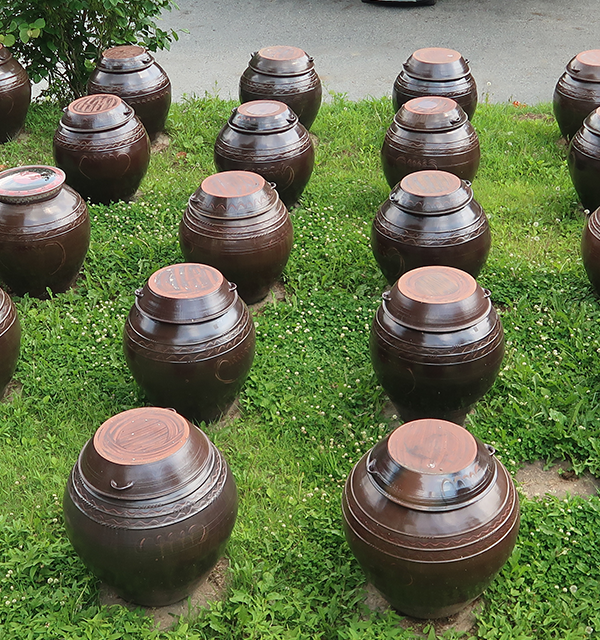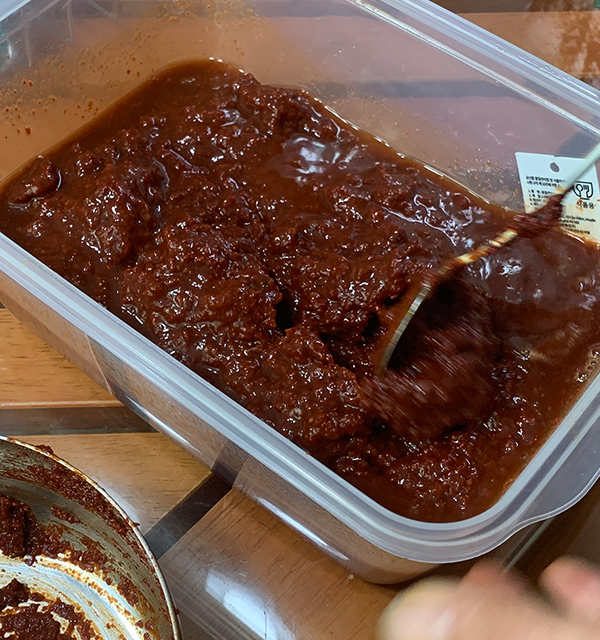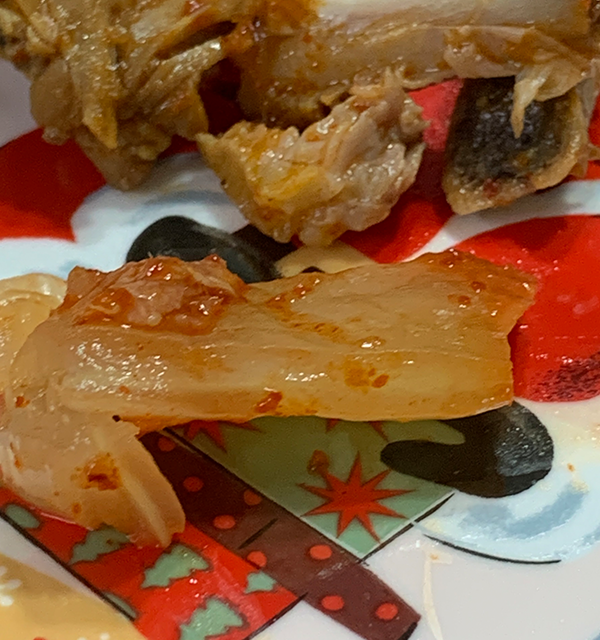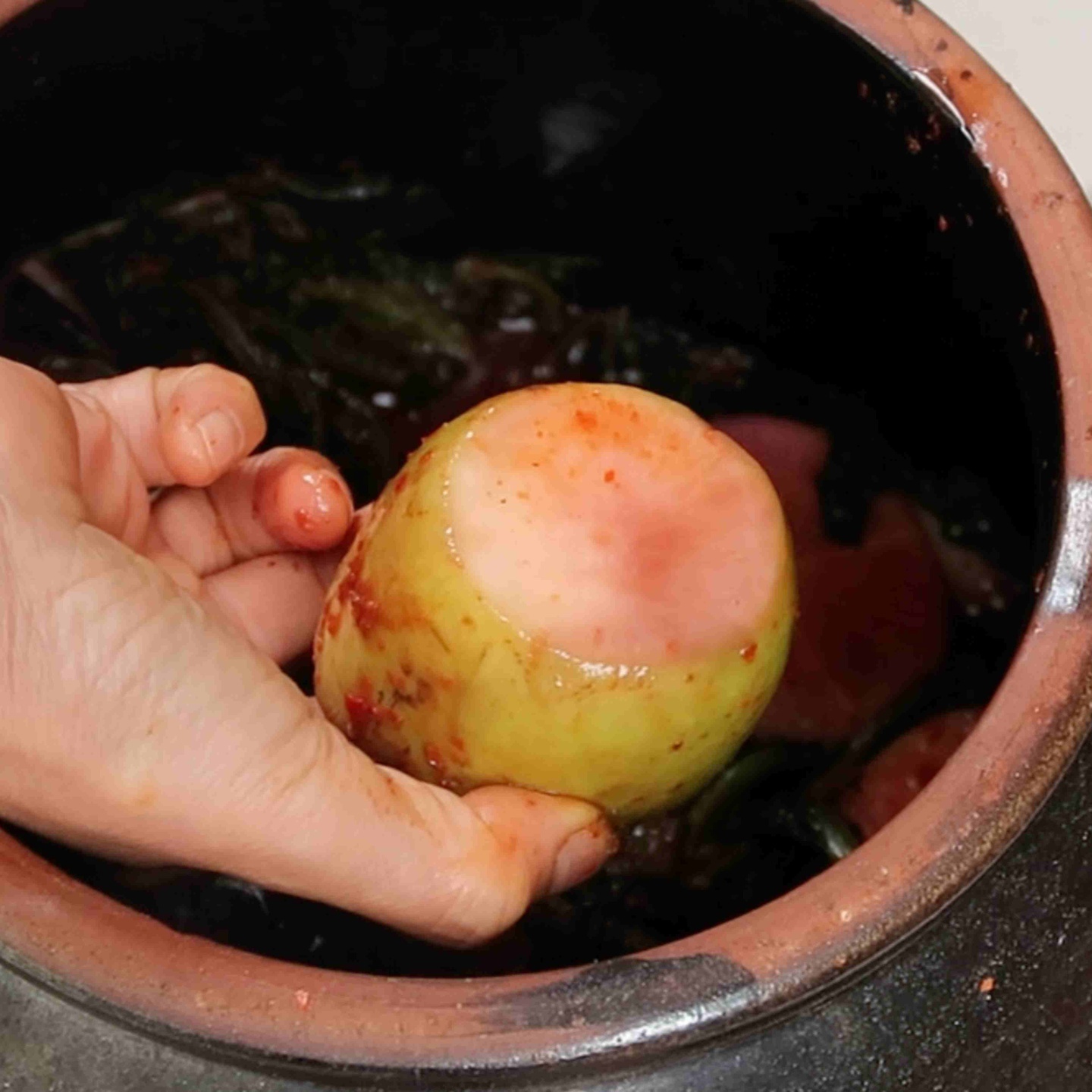Step #2: Brining your vegetable
The second step is to brine your cabbage. Brining your cabbage helps to ensure flavorful kimchi at the core. But brining your cabbage does more than just add the salty flavor that makes kimchi delicious. There is a science behind why we brine! Osmotic pressure is the reason we brine. To simplify what this means, basically by soaking the cabbage in the salt water, the water inside the cabbage will be released. Since the water in the cabbage is released, that means there is less water in the cabbage, therefore the cabbage will absorb the sauce and seasoned juices quicker and more efficiently. Brining also allows for better fermentation and removes any grassy/fresh veggie odor that may be present.
Adding salt to kimchi is an important step to fermentation and preservation. Salt helps to stop the growth of unwanted bacteria that would usually make food deteriorate and rot. If too much salt is added, it can kill lactic acid.
It is best to use coarse sea salt when brining. Using coarse sea salt helps to keep the cabbage firm after brining. Finer salt can make the cabbage get mushy quicker. The salt most commonly used to brine kimchi in Korea is a type of coarse sea salt or bay salt called 천일염. This salt is used because it contains added vitamins and nutrients like calcium that are then added to your kimchi, making it even more nutritious. I know this salt is not readily available to everyone so I will share some substitutes that can be used. It is good to use salts that are clean and have some added nutrients. Try to find the coarse version of these salts: Morton’s salt, Himalayan pink salt, sea salt, pickling salt, and kosher salt are all possible substitutes.
Now let’s get back to the actual brining steps.
- The first step was to make the brining liquid. This liquid consists of coarse salt completely blended with fresh cold water. You should use cold water or room temp to brine the cabbage because although using warm water may speed up the brining process, it can cook the cabbage and cause the cabbage to smell. So, take your prepped halved pieces of cabbage and fully submerge the cabbage into the salt water. Make sure it gets into each crevice and leaf of the cabbage. Take the cabbage out and place it to the side in a bowl. Making this cabbage wet like this also allows the extra salt we add to cling to the cabbage better.
- The next step is to add coarse salt to the inner leaves of the cabbage to make sure that the base is fully brined and salted. This is done because the brine can get diluted as the water from the cabbage is release into the brine. The outer leaves of the cabbage will brine quicker because they are thinner. That is why we need to make sure the thicker dense base/stem of the cabbage is properly salted. Add coarse salt in between each leaf of the cabbage, all over the leaf, but concentrate on adding extra salt to the base of the cabbage.
- The final step is to pour the saltwater that we used in step 1 onto the cabbage. Make sure the water is covering the cabbage, but don’t worry if it is not fully submerged because you will flip the cabbage as it brines to ensure an even brine.
Brining in a bag vs a bowl
Before we move on, I want to cover some vessels you can use to brine. We will cover using a bowl or using a large plastic bag.
First let’s talk about brining your cabbage in a bag. Using a bag can be easier because it makes tossing the cabbage in the salt brine way easier because all you have to do is periodically shake the cabbage around in the bag. It can help to ensure that the cabbage is brining evenly.
Now when it comes to using a bowl. Try to find the largest bowl possible in your kitchen or place the cabbages in multiple bowls. There are also large thick plastic kimchi tubs called 다라이 that you can purchase that make brining kimchi very easy. Since I purchased one, I can place all my cabbage halves into one container and ensure an even brine. Try looking on amazon or at your local Asian market in the cookware section.
When you use a bowl to brine there are some things you need to consider. You want to make sure that the cabbage halves are kept right side up, this helps to ensure that the salt and salt brine is kept inside the cabbage leaves. Another thing to keep in mind is that you need to flip your cabbage every so many hours in the bowl to ensure an even brine. I would recommend flipping your cabbage around in the brine every 3-5 hours. A final extra option you can do to ensure an even brine is to use a separate clean bowl or plate to weigh the cabbage down into the brine liquid. Again, all these steps are done to try to brine the cabbage as evenly as possible.
How long do you need to brine your cabbage
Now that we finished the brining prep, let’s talk about how long we actually brine our cabbage.
The following time line is for the whole brined cabbage. You can make already cut up cabbage kimchi. If you start the process of brining using cut up cabbage then those pieces of cabbage will brine quicker than if you were to brine the cabbage whole like I had been explaining so only use this as a reference for whole brined cabbage.
- In the summer: you can brine the cabbage for 8-12 hours. Keep in mind that the warmer temperature can make the cabbage brine quicker, so monitor it well.
- In the winter: brine the cabbage for 24 hours. Again remember, you should flip your cabbage around in the brine every so many hours to make sure that it is evenly brining.
Tests to see if your cabbage is done brining
When you make kimchi, the cabbage has to be a little bit on the salty side that way even when water comes out from the cabbage it will not be bland and as it ferments the flavor will continue to get better. If in the end your kimchi is too bland you may not have added enough salt while brining but don’t worry it is not ruined, you can always add fish sauce to your kimchi seasoning paste at the end to achieve the flavor you want.
So how can you tell if your cabbage is done brining? Well, there are two ways that you can test to see if your cabbage is properly brined and is now ready to be washed and seasoned.
The first test is to bend the leaves of the cabbage.
Properly brined cabbage should bend without breaking. If the leaves snap when bent then they should be brined longer.
If the cabbage passed the bend test, it is now time to taste the cabbage. Tasting the cabbage is the second test. As I mentioned before, the outer leaves of the cabbage will brine quicker than the center, so you want to take a piece of cabbage from the center to see if it is properly brined and seasoned well. The cabbage should taste salty but not so salty that you want to spit out the cabbage. It should be on the salty side. If your cabbage is so salty that you can’t eat it then you may need to wash and soak the cabbage for a couple hours in cold fresh water to remove the excess salt. If it’s a “good salty” then that will make the kimchi taste more delicious as it ferments. You will be able to tell the difference as you make kimchi and practice.
Wash in cold water after brining
Now that you know your cabbage is done brining, you can wash the salt off the cabbage. Use fresh cold water to wash the salt off the cabbage. Submerge the cabbage in the cold water and wash thoroughly at least 3 times to remove all the excess salt. You can pull the cabbage halves in half by pulling apart the cabbage at the split section on the base of the cabbage. This can help you to get to and remove the salt from the center of the cabbage.
After washing, let the water drain completely from the cabbage by placing it in a colander or on a wicker basket. If you do not let the cabbage drain then the water will dilute the seasoned red pepper paste and you will get bland watery kimchi. It only needs to drain for about 20 minutes.
Once your cabbage is drained it is now time to season the cabbage with the paste.
It is very important to wash the excess salt off the cabbage for multiple reasons.
- The excess salt will prevent some bacteria from growing, which will mess up your fermentation.
- The liquid that comes out of the vegetables as they brine tastes bitter and so you need to wash away that bitter flavor.





